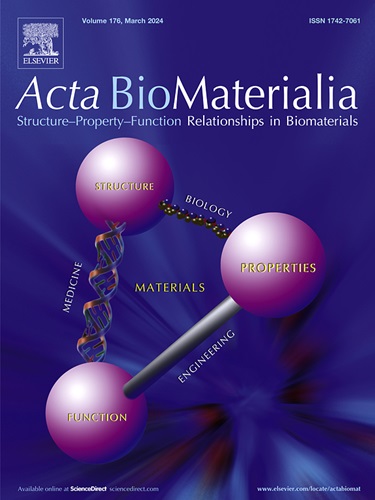Improved tendon repair with optimized chemically modified mRNAs: Combined delivery of Pdgf-BB and IL-1Ra using injectable nanoparticles
IF 9.4
1区 医学
Q1 ENGINEERING, BIOMEDICAL
引用次数: 0
Abstract
Tendon injuries, common in both athletic and non-athletic populations, present significant challenges due to their slow healing and the formation of scar tissue, which impairs function and potentially increases the risk of (re-)rupture. Conventional treatments often yield suboptimal functional and structural repair. This study investigates the potential of mRNA-based therapeutics to enhance tendon healing by targeting 2 distinct pathways via the delivery of chemically modified ARCA-capped mRNAs (cmRNAs) encoding Interleukin-1 receptor antagonist (IL1RA) and Platelet-Derived Growth Factor-BB (PDGF-BB) using injectable nanoparticle (NP) carriers. In vitro experiments demonstrate successful cmRNA delivery and translation, resulting in increased tendon cell proliferation, migration, and anti-inflammatory responses. In vivo, cmRNA treatment notably enhances tendon repair in a rat patellar tendon defect model, by reducing pro-inflammatory cytokines and fibrotic markers while enhancing repair tissue structure. These findings suggest that NP-based cmRNA delivery represents a promising therapeutic strategy for improving tendon healing, offering better outcomes over existing treatments by targeting both inflammatory and regenerative pathways.
Statement of significance
In this study, we investigate an mRNA-based therapeutic approach aimed at enhancing tendon healing in a small animal model. Utilizing bioreducible poly(amidoamine)-based polymeric nanoparticles (PAA PNPs) for the delivery of cmRNAs encoding Interleukin-1 receptor antagonist (IL1RA) and Platelet-Derived Growth Factor-BB (PDGF-BB), we demonstrate effective delivery and protein translation in vitro and ex vivo, resulting in enhanced tendon cell proliferation, migration, and robust anti-inflammatory responses. By combining these therapeutic cmRNAs, we show improved tendon repair in vivo, with accelerated tissue regeneration, better collagen fiber organization, and signs of reduced fibrotic scarring. These findings highlight the potential of nanoparticle-mediated cmRNA delivery targeting two distinct pathways to improve tendon healing, offering a promising alternative to current treatments that often yield suboptimal results.

求助全文
约1分钟内获得全文
求助全文
来源期刊

Acta Biomaterialia
工程技术-材料科学:生物材料
CiteScore
16.80
自引率
3.10%
发文量
776
审稿时长
30 days
期刊介绍:
Acta Biomaterialia is a monthly peer-reviewed scientific journal published by Elsevier. The journal was established in January 2005. The editor-in-chief is W.R. Wagner (University of Pittsburgh). The journal covers research in biomaterials science, including the interrelationship of biomaterial structure and function from macroscale to nanoscale. Topical coverage includes biomedical and biocompatible materials.
 求助内容:
求助内容: 应助结果提醒方式:
应助结果提醒方式:


